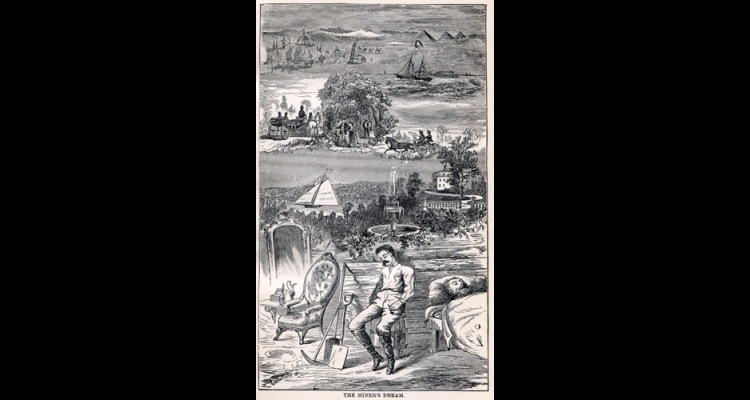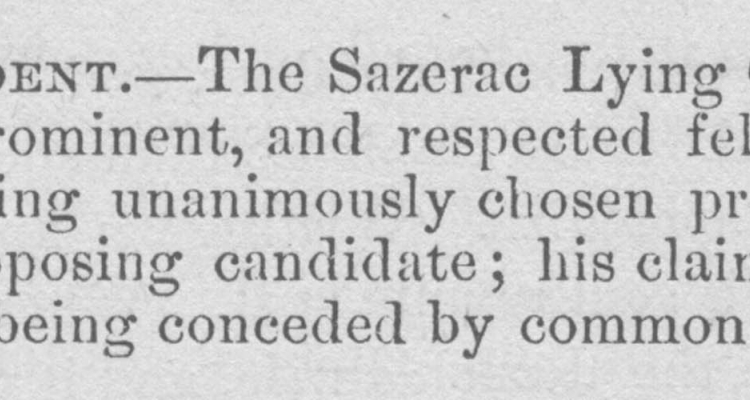Sagebrush School
The main contribution to American literature from Nevada's mining frontier, 1859 to 1914, was the writing of the Sagebrush School. It was a major contribution, more important than other, better-known regional movements. Like New England's transcendentalism, the Sagebrush School was a loose, somewhat informal association of writers. In this case it refers to authors who either lived and worked in Nevada or spent formative years there during its mining booms. Also like transcendentalism it lacked a sharply defining creedal test, and resulted in several distinguished authors who emerged from a larger but vaguely-defined pool of minor, certainly less well-known colleagues. In place of Emerson, Thoreau, and Margaret Fuller, it was Mark Twain and, to a lesser extent, Dan De Quille and Sam Davis. But none of these authors developed in a vacuum, and their interactions with their "minor" colleagues are certainly manifold and of incalculable importance.
The term "Sagebrush School" suggests an origin in a vernacular, perhaps jocular, designation from a more organized literary center, probably California. One of the earliest formal uses of the term occurs in Ella Sterling Cummins's Story of the Files (1893), her pioneering survey of California (and Nevada) authors and literature prepared as one of California's contributions to the World's Columbian Exposition in Chicago. Her chapter headings reflect a necessarily loose and arbitrary categorization of her material, e.g. "The Golden Era School," "The Argonaut School," "the Overland School,"—using as centers of movements the names of periodicals in which authors published. Of course this was inexact and there was a great deal of overlap, but at the time she wrote she did the best she could with material difficult of provenance and to this day her categories retain some degree of serviceability.
Today, however, it is possible to suggest a constellation of common characteristics, attitudes, and literary techniques which, though still imperfectly, help distinguish Sagebrush literature from that of neighboring regions. To begin with, Sagebrush authors tended to be intelligent and accomplished writers. The gold and silver mining which occurred in Nevada was to a large extent a technological phenomenon. Unlike California's gold rush, for which prospective miners needed only a pick, shovel, and a pan as equipment because gold occurs free, as nuggets or dust, Nevada's mining boom consisted mainly of silver deposits. Because silver normally reacts with other minerals, the process of mining it requires a heavy investment in extractive technologies and technologically sophisticated employees. The industrial enterprises which established themselves near deposits of silver offered generous returns to mining engineers, financiers, lawyers, and doctors, and incidentally attracted journalists who also made good livings in the booming economy. As a result, the self-selected men who came to Nevada tended to be not only ambitious but also intelligent and skilled, and often educated. Even a quick skimming of Nevada newspapers of the time shows that their editors and reporters took pride in being able to write correct English and to indulge their interest in the world of ideas. In short, the Sagebrush authors who came out of Nevada journalism began with intellectual capabilities that set them above the average of their profession. From the start, Sagebrush literature often displays psychological sensitivity and moral complexity.
As for the stylistic characteristics of the Sagebrush School, the chief one was a fascination with hoaxes, but others included delight in wit, audacity, and an irreverent attitude toward inflated authority and outworn tradition. While hoaxes were not unique to Nevada, in Nevada they were an everyday phenomenon. The stakes of wealth were so high on the Comstock and the hoaxers so sophisticated that law was all but a mockery; almost everything had a price. Caveat emptor was the ruling standard. More often than not, the law was what the strongest or wealthiest parties said it was. Witnesses, judges, and entire juries could be bought off, perjury was commonplace, and most lawmen prized discretion above valor. Immersed in this almost lawless society, Sagebrush authors naturally reflected it by incorporating hoaxes into their writings and, inspired by real life examples, raised the hoax to a high art. For the most part, however, although Sagebrush writers were witnesses to social Darwinism at its worst, they themselves tended to be relatively moral and to respect personal integrity, honor, and courage. Unlike the hoaxes they described, their literary hoaxes were harmless and, in fact, could serve as instructive warnings to the inexperienced.
Although it was popular and influential in its day, Sagebrush literature experienced a near eclipse in the twentieth century for the simple reason that most of it remained uncollected in the newspapers and magazines of its own time. Not until it was rediscovered at the end of the twentieth century and the beginning of the twenty-first, even the term "Sagebrush School" had almost lost its meaning. Twain scholarship might have preserved the term, except that Twain scholars did not pursue his Sagebrush origins. They missed his central assimilation of some Sagebrush characteristics into his permanent style and focused on other influences.
Nevertheless, it was the study of Mark Twain that finally revived the Sagebrush School. In the scholarly effort to ascertain what if any influences played upon Twain during his Nevada years, his impressive newspaper colleague Dan De Quille was first rediscovered and republished. Next, their colleagues Joe Goodman and Rollin Daggett were revived, and after that the versatile and talented Sam Davis. Preliminary work has been done on others, e.g. C. C. Goodwin, Thomas Fitch, Fred Hart, Alf Doten, Arthur McEwen, and James Gally. A host of lesser-known authors remain to be researched. What has come out of these belated restorations, however, is the realization that not only was Mark Twain formed and inspirited by the Sagebrush School, but that Sagebrush literature, once recovered, is of surprising quality and uniquely illuminates an overlooked but important aspect of American culture.
Article Locations
Related Articles
None at this time.
Further Reading
None at this time.




